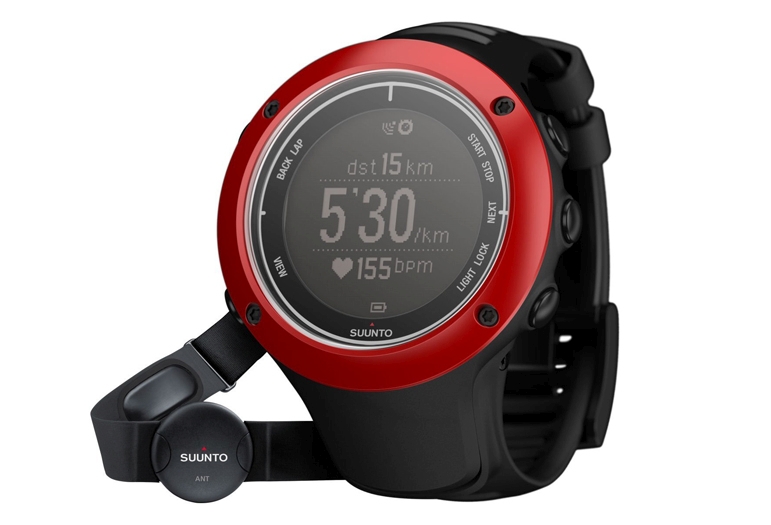If you want to know how hard you’re working at any particular moment in time, you can strap on a heart rate monitor. But how can you monitor the cumulative fatigue of successive workouts in order to plan your training program to give you maximum performance with minimal risk of overtraining? According to Eddie Fletcher, new heart rate monitoring technology now means that there is a way.All competitive athletes need to walk a tightrope, balancing maximum training intensity and duration for fitness gains on the one hand with sufficient rest and recovery on the other. Get his balance right and you’ll optimise the training effect. Get it wrong and injury/overtraining will inevitably follow.
Although heart rate monitors (HRMs) can tell you your instantaneous heart rate, estimate percentage of maximum oxygen uptake and even your lactate threshold, what they can’t do is provide information on the cumulative training effects of cardiovascular workouts. However, new technology in HRMs now enables some models to measure heart rate variability (HRV).
Understanding heart rate variability
If you were to measure the time elapsed between distinct heart beats, you would discover that even when the overall heart rate is constant, the time interval between beats (beat–to-beat interval) is not constant, but varies slightly by a few milliseconds. When you’re at rest, the beat interval increases during exhalation (drop in heart rate) and decreases during inhalation. These differences are due to the influence of the autonomic nervous system (ANS), which automatically helps to regulate body functions without the need for conscious effort.The component of the ANS responsible for increasing heart rate (sympathetic activity) dominates during exercise, leading to two effects; heart rate speeds up and HRV decreases. Scientists have been able to use these facts to link HRV variability to accumulated physiological stress and fatigue in the body. In very simple terms, the more physiologically relaxed and unstressed the body is, the greater the HRV.
Therefore during exercise, HRV drops, indicating increased physiological stress. Moreover, reduced HRV in a subsequent exercise session compared to an initial session can indicate incomplete recovery, reduced hydration or the presence of other external stressors. A number of other factors can alter the magnitude of HRV; these include age, gender, genetic makeup, the mode of exercise and environmental considerations1.
HRV and athletic performance
During prolonged and heavy training, the body accumulates physiological fatigue and HRV decreases. But when rest and recovery follows, there’s a corresponding increase in HRV. It follows therefore that HRV can be used to assess whether adequate recovery has occurred between training sessions, and therefore the ‘physiological loading’ placed on the body by a particular training session.Athletes have always known that longer and harder sessions have required more time for full recovery and that high volume/high intensity sessions without adequate recovery can lead to under-recovery and overtraining. HRV measurement now allows them to measure it!
HRV and excess post exercise consumption (EPOC)
EPOC refers to the amount of oxygen (in millilitres of O2 per kilo of body weight) required by the body to recover after training. Research has shown that EPOC can be calculated from HRV during exercise and that higher the EPOC value, the more physiological and cardiovascular fatigue that has occurred during exercise2.As a rule of thumb higher intensity training also produces higher EPOC values; duration tends to be less of a factor unless it is exceptionally long. However, high intensity longer duration sessions are very effective at producing high EPOC values! It’s important to remember that EPOC measures accumulated fatigue after one or several exercise sessions, which is why it can be used to measure recovery (or lack of it), whereas conventional HRMs only measure instantaneous fatigue. Two exercise sessions may be equally hard in terms of heart rates, but if the second one takes places after insufficient recovery from the first, the resulting EPOC value will be higher even though the same heart rate was recorded for both workouts.
By comparing EPOC values for workouts, we can detect whether recovery is adequate, or fatigue is accumulating; a higher EPOC value for successive workouts indicates under-recovery. The HRM company Suunto has released a HRM onto the market (Suunto t6) that allows users to collect EPOC data for workouts using HRV measurement and display it graphically on a PC.
During a marathon rowing workout for example, it can be seen that while the heart rate stays fairly constant at below 90% maximum, the EPOC value rises steadily throughout the 2hrs 40mins, indicating steadily accumulating physiological fatigue.
Meanwhile, overlay plots of rowers performing interval sessions on separate occasions show that when recovery is adequate, the EPOC plots for these workouts are virtually superimposed upon one another and almost appear as one line, but if it is insufficient, successive EPOC plots are seen to incur steeper and steeper gradients, indicating steadily accumulating fatigue over a period of days and weeks. Indeed, even just one extremely long and strenuous workout lead to raised EPOC values for several weeks afterwards!
Summary
Although HRV is still a relatively unexplored concept, research shows that it can be used to generate valuable information about accumulated physiological and cardiovascular fatigue, and therefore recovery. This information can in turn help athletes and coaches plan better training programs and reduce the risk of overtraining.References:
1. Sports Med. 2003; 33 (12): 889-919.
2. Med Sci Sports Exerc. 2003; 35 (5): Supp, 1 May p S183
Original article by Eddie Fletcher; summary by Andrew Hamilton BSc Hons MRSC ACSM










